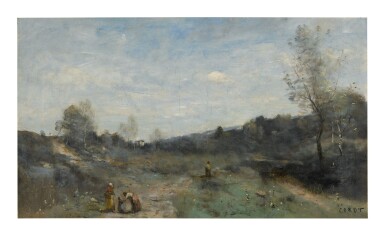
Property of a Private New York Collector
JEAN-BAPTISTE-CAMILLE COROT | VALLONS DÉFRICHÉS
Lot Closed
June 11, 04:16 PM GMT
Estimate
150,000 - 200,000 USD
Lot Details
Description
Property of a Private New York Collector
JEAN-BAPTISTE-CAMILLE COROT
French
1796 - 1875
VALLONS DÉFRICHÉS
signed Corot (lower right)
oil on canvas
canvas: 13¾ by 24 in.; 34.9 by 60.9 cm
framed: 25¼ by 35 ½ in.; 64.1 by 90.1 cm
We would like to thank Martin Dieterle and Claire Lebeau for kindly confirming the authenticity of this lot.
Galerie Bonjean, Paris (acquired by 1870)
Boussod, Valadon & Cie, Paris (acquired by 1905)
O'Bach & Co., London (acquired by 1912)
Thomas McLean, London
Private Collection (acquired circa 1920)
Private Collection, Washington, D.C. (by descent through the family from the above and sold: Christie's, New York, April 29, 2013, lot 5, Christie's, New York, April 29, 2013, lot 5, illustrated)
Acquired at the above sale
Alfred Robaut, L'Oeuvre de Corot, Catalogue raisonné et illustré, vol. III, Paris, 1965, no. 1937, illustrated p. 223
Painted circa 1865-70, Vallons défrichés is representative of Jean-Baptiste-Camille Corot’s artistic ingenuity and painterly freedom at the height of his prolific career. Crisp hues of blue and green are balanced by his characteristic planes of ambiguous color which describe the sun-struck landscape. A tall willowy birch, with its glittering silver foliage, stands at right, and the ground is punctuated with confetti-like flowers. Summarily painted figures animate the scene and emphasize Corot’s enduring connection to the pastoral landscape.
In the last fifteen years of his life, Corot experienced a renewal of critical appreciation for his work. Collectors and dealers eagerly sought out his canvases, and throughout the 1860s and 1870s he was readily included in the Paris Salon, either because he was on the jury himself, or automatically admitted hors concours (a departure from his difficulties in the 1840s and 1850s). In 1877 the French Art critic Charles Blanc remembered that Corot “was loved like a comrade and respected like a master” (as quoted in Gary Tinterow, Michael Pantazzi, Vincent Pomarède, Corot, exh. cat., The Metropolitan Museum of Art, New York, 1996, p. 259). Seeking his instruction and approval was a younger generation of painters including Berthe Morisot and Camille Pissarro, identified as a pupil of Corot in Salon brochures as a sign of respect, while Claude Monet, Pierre-Auguste Renoir and Alfred Sisley each experimented with the artist’s techniques in the 1860s. In 1897, Monet wrote “There is only one master here—Corot. We are nothing compared to him, nothing” (as quoted in Tinterow, p. xiv).
